Djibouti: Difference between revisions
Extended confirmed users 41,755 edits No edit summary |
Rescuing 1 sources and tagging 1 as dead. #IABot (v1.6.1) (Balon Greyjoy) |
||
| Line 83: | Line 83: | ||
Pottery predating the mid-2nd millennium has been found at [[Asa Koma]], an inland lake area on the Gobaad Plain. The site's ware is characterized by punctate and incision geometric designs, which bear a similarity to the Sabir culture phase 1 ceramics from Ma'layba in [[Southern Arabia]].<ref name="Ohvah">{{cite book|last1=Walter Raunig|first1=Steffen Wenig|title=Afrikas Horn|date=2005|publisher=Otto Harrassowitz Verlag|isbn=3447051752|page=439|url=https://www.google.com/books?id=JpNY7VPn1WUC|accessdate=7 September 2014}}</ref> Long-horned humpless cattle bones have likewise been discovered at Asa Koma, suggesting that domesticated cattle were present by around 3,500 years ago.<ref name="Connah">{{cite book|last1=Connah|first1=Graham|title=Forgotten Africa: An Introduction to Its Archaeology|date=2004|publisher=Routledge|isbn=1134403038|page=46|url=https://www.google.com/books?id=ggD1wdQxBOcC|accessdate=7 September 2014}}</ref> Rock art of what appear to be antelopes and a giraffe are also found at [[Dorra]] and [[Balho]].<ref name="Amvjaa">{{cite book|last1=Universität Frankfurt am Main|title=Journal of African Archaeology, Volumes 1–2|date=2003|publisher=Africa Manga Verlag|page=230|url=https://www.google.com/books?id=ExwkAQAAIAAJ|accessdate=7 September 2014}}</ref> [[Handoga]], dated to the fourth millennium BP, has in turn yielded obsidian microliths and plain ceramics used by early nomadic pastoralists with domesticated cattle.<ref>{{cite book|last1=Finneran|first1=Niall|title=The Archaeology of Ethiopia|date=2013|publisher=Routledge|location=1136755527|isbn=1136755527|page=86|url=https://www.google.com/books?id=MNGIzz1VJH0C|accessdate=29 December 2016}}</ref> |
Pottery predating the mid-2nd millennium has been found at [[Asa Koma]], an inland lake area on the Gobaad Plain. The site's ware is characterized by punctate and incision geometric designs, which bear a similarity to the Sabir culture phase 1 ceramics from Ma'layba in [[Southern Arabia]].<ref name="Ohvah">{{cite book|last1=Walter Raunig|first1=Steffen Wenig|title=Afrikas Horn|date=2005|publisher=Otto Harrassowitz Verlag|isbn=3447051752|page=439|url=https://www.google.com/books?id=JpNY7VPn1WUC|accessdate=7 September 2014}}</ref> Long-horned humpless cattle bones have likewise been discovered at Asa Koma, suggesting that domesticated cattle were present by around 3,500 years ago.<ref name="Connah">{{cite book|last1=Connah|first1=Graham|title=Forgotten Africa: An Introduction to Its Archaeology|date=2004|publisher=Routledge|isbn=1134403038|page=46|url=https://www.google.com/books?id=ggD1wdQxBOcC|accessdate=7 September 2014}}</ref> Rock art of what appear to be antelopes and a giraffe are also found at [[Dorra]] and [[Balho]].<ref name="Amvjaa">{{cite book|last1=Universität Frankfurt am Main|title=Journal of African Archaeology, Volumes 1–2|date=2003|publisher=Africa Manga Verlag|page=230|url=https://www.google.com/books?id=ExwkAQAAIAAJ|accessdate=7 September 2014}}</ref> [[Handoga]], dated to the fourth millennium BP, has in turn yielded obsidian microliths and plain ceramics used by early nomadic pastoralists with domesticated cattle.<ref>{{cite book|last1=Finneran|first1=Niall|title=The Archaeology of Ethiopia|date=2013|publisher=Routledge|location=1136755527|isbn=1136755527|page=86|url=https://www.google.com/books?id=MNGIzz1VJH0C|accessdate=29 December 2016}}</ref> |
||
Additionally, between Djibouti City and Loyada are a number of [[Anthropomorphism|anthropomorphic]] and phallic [[Stele|stelae]]. The structures are associated with graves of rectangular shape that are flanked by vertical slabs, as also found in central [[Ethiopia]]. The Djibouti-Loyada stelae are of uncertain age, and some of them are adorned with a T-shaped symbol.<ref name="Fattovich">{{cite journal|last1=Fattovich|first1=Rodolfo|title=Some remarks on the origins of the Aksumite Stelae|journal=Annales d'Éthiopie|year=1987|volume=14|issue=14|pages=43–69|url=http://www.persee.fr/articleAsPDF/ethio_0066-2127_1987_num_14_1_931/article_ethio_0066-2127_1987_num_14_1_931.pdf|accessdate=7 September 2014}}</ref> |
Additionally, between Djibouti City and Loyada are a number of [[Anthropomorphism|anthropomorphic]] and phallic [[Stele|stelae]]. The structures are associated with graves of rectangular shape that are flanked by vertical slabs, as also found in central [[Ethiopia]]. The Djibouti-Loyada stelae are of uncertain age, and some of them are adorned with a T-shaped symbol.<ref name="Fattovich">{{cite journal|last1=Fattovich|first1=Rodolfo|title=Some remarks on the origins of the Aksumite Stelae|journal=Annales d'Éthiopie|year=1987|volume=14|issue=14|pages=43–69|url=http://www.persee.fr/articleAsPDF/ethio_0066-2127_1987_num_14_1_931/article_ethio_0066-2127_1987_num_14_1_931.pdf|accessdate=7 September 2014}}{{dead link|date=November 2017 |bot=InternetArchiveBot |fix-attempted=yes }}</ref> |
||
===Punt=== |
===Punt=== |
||
| Line 103: | Line 103: | ||
{{main article|Egypt Eyalet}} |
{{main article|Egypt Eyalet}} |
||
[[File:OttomanEmpire1566.png|thumb|The [[Egypt Eyalet|Ottoman Eyalet]] in 1566.]] |
[[File:OttomanEmpire1566.png|thumb|The [[Egypt Eyalet|Ottoman Eyalet]] in 1566.]] |
||
Governor Abou Baker ordered the Egyptian garrison at [[Sagallo]] to retire to [[Zeila]]. The cruiser Seignelay reached Sagallo shortly after the Egyptians had departed. French troops occupied the fort despite protests from the British Agent in [[Aden]], Major Frederick Mercer Hunter, who dispatched troops to safeguard British and Egyptian interests in [[Zeila]] and prevent further extension of French influence in that direction.<ref name="awdalpress.com"> |
Governor Abou Baker ordered the Egyptian garrison at [[Sagallo]] to retire to [[Zeila]]. The cruiser Seignelay reached Sagallo shortly after the Egyptians had departed. French troops occupied the fort despite protests from the British Agent in [[Aden]], Major Frederick Mercer Hunter, who dispatched troops to safeguard British and Egyptian interests in [[Zeila]] and prevent further extension of French influence in that direction.<ref name="awdalpress.com">{{cite web |url=http://www.awdalpress.com/index/archives/16528 |title=Archived copy |accessdate=2013-04-19 |deadurl=yes |archiveurl=https://web.archive.org/web/20130609002748/http://www.awdalpress.com/index/archives/16528 |archivedate=9 June 2013 |df=dmy-all }} FRENCH SOMALI COAST Timeline</ref> |
||
On 14 April 1884 the Commander of the patrol sloop L'Inferent reported on the Egyptian occupation in the Gulf of Tadjoura. The Commander of the patrol sloop Le Vaudreuil reported that the Egyptians were occupying the interior between [[Obock]] and [[Tadjoura]]. Emperor [[Yohannes IV]] of Ethiopia signed an accord with Great Britain to cease fighting the Egyptians and to allow the evacuation of Egyptian forces from [[Ethiopia]] and the Somalia littoral. The Egyptian garrison was withdrawn from [[Tadjoura]]. Léonce Lagarde deployed a patrol sloop to [[Tadjoura]] the following night. |
On 14 April 1884 the Commander of the patrol sloop L'Inferent reported on the Egyptian occupation in the Gulf of Tadjoura. The Commander of the patrol sloop Le Vaudreuil reported that the Egyptians were occupying the interior between [[Obock]] and [[Tadjoura]]. Emperor [[Yohannes IV]] of Ethiopia signed an accord with Great Britain to cease fighting the Egyptians and to allow the evacuation of Egyptian forces from [[Ethiopia]] and the Somalia littoral. The Egyptian garrison was withdrawn from [[Tadjoura]]. Léonce Lagarde deployed a patrol sloop to [[Tadjoura]] the following night. |
||
Revision as of 11:34, 17 November 2017
11°30′N 43°00′E / 11.500°N 43.000°E
Republic of Djibouti | ||
|---|---|---|
| Motto: اتحاد، مساواة، سلام ( Prime Minister | Abdoulkader Kamil Mohamed | |
| Legislature | National Assembly | |
| Independence | ||
• from France | 27 June 1977[1] | |
+253 | ||
| ISO 3166 code | DJ | |
| Internet TLD | .dj | |
Djibouti (
In antiquity, the territory was part of the
Djibouti is a multi-ethnic nation with a population of over 1,105,557 inhabitants.
Djibouti is strategically located near some of the world's busiest shipping lanes, controlling access to the Red Sea and Indian Ocean. It serves as a key refuelling and transshipment center, and is the principal maritime port for imports from and exports to neighboring Ethiopia. A burgeoning commercial hub, the nation is the site of various foreign military bases, including Camp Lemonnier. The Intergovernmental Authority on Development (IGAD) regional body also has its headquarters in Djibouti City.[1]
History
Prehistory

The Djibouti area has been inhabited since at least the

Pottery predating the mid-2nd millennium has been found at
Additionally, between Djibouti City and Loyada are a number of anthropomorphic and phallic stelae. The structures are associated with graves of rectangular shape that are flanked by vertical slabs, as also found in central Ethiopia. The Djibouti-Loyada stelae are of uncertain age, and some of them are adorned with a T-shaped symbol.[19]
Punt
Together with northern Somalia, Eritrea and the Red Sea coast of Sudan, Djibouti is considered the most likely location of the territory known to the Ancient Egyptians as Punt (or Ta Netjeru, meaning "God's Land"). The first mention of the Land of Punt dates to the 25th century BC.[20] The Puntites were a nation of people who had close relations with Ancient Egypt during the reign of the 5th dynasty Pharaoh Sahure and the 18th dynasty Queen Hatshepsut.[21] According to the temple murals at Deir el-Bahari, the Land of Punt was ruled at that time by King Parahu and Queen Ati.[22]
Ifat Sultanate (1285–1415)
Through close contacts with the adjacent
Adal Sultanate (1415–1577)
Ottoman Eyalet (1577–1867)
Governor Abou Baker ordered the Egyptian garrison at Sagallo to retire to Zeila. The cruiser Seignelay reached Sagallo shortly after the Egyptians had departed. French troops occupied the fort despite protests from the British Agent in Aden, Major Frederick Mercer Hunter, who dispatched troops to safeguard British and Egyptian interests in Zeila and prevent further extension of French influence in that direction.[29]
On 14 April 1884 the Commander of the patrol sloop L'Inferent reported on the Egyptian occupation in the Gulf of Tadjoura. The Commander of the patrol sloop Le Vaudreuil reported that the Egyptians were occupying the interior between Obock and Tadjoura. Emperor Yohannes IV of Ethiopia signed an accord with Great Britain to cease fighting the Egyptians and to allow the evacuation of Egyptian forces from Ethiopia and the Somalia littoral. The Egyptian garrison was withdrawn from Tadjoura. Léonce Lagarde deployed a patrol sloop to Tadjoura the following night.
French Somaliland (1894–1977)

From 1862 until 1894, the land to the north of the
In 1958, on the eve of neighboring Somalia's independence in 1960, a
In 1967, a
Djibouti Republic
In 1977, a
During its first year, Djibouti joined the
In the early 1990s, tensions over government representation led to armed conflict between Djibouti's ruling People's Rally for Progress (PRP) party and the Front for the Restoration of Unity and Democracy (FRUD) opposition group. The impasse ended in a power-sharing agreement in 2000.[1]
Politics
Djibouti is a
Governance
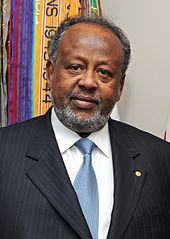
The
The judicial system consists of courts of first instance, a High Court of Appeal, and a Supreme Court. The
The National Assembly (formerly the Chamber of Deputies) is the country's legislature,

The
The government is dominated by the Somali
Djibouti's current president, Guelleh, succeeded
On 31 March 2013, Guelleh replaced long-serving Prime Minister
Foreign relations
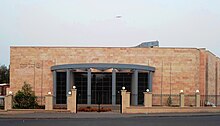
Foreign relations of Djibouti are managed by the Djiboutian Ministry of Foreign Affairs and International Cooperation. Djibouti maintains close ties with the governments of Somalia, Ethiopia, France and the United States. Relations with Eritrea are tense due to territorial claims over the Ras Doumeira peninsula. Since the 2000s, the Djiboutian authorities have strengthened ties with China. Djibouti is likewise an active participant in Arab League and African Union affairs.
Human rights
In its 2011 Freedom in the World report, Freedom House ranked Djibouti as "Not Free", a downgrading from its former status as "Partly Free".
There are occasional reports of police beating prisoners. Reporters Without Borders claims that Dirir Ibrahim Bouraleh died from injuries sustained under torture by Sergeant Major Abdourahman Omar Said from 23–27 April 2011. Conditions in the jails are considered worse, with no formal system of care.
Security forces frequently make illegal arrests.
Military

The
database). After independence, Djibouti had two regiments commanded by French officers. In the early 2000s, it looked outward for a model of army organization that would best advance defensive capabilities by restructuring forces into smaller, more mobile units instead of traditional divisions.The first war which involved the Djiboutian Armed Forces was the Djiboutian Civil War between the Djiboutian government, supported by France, and the Front for the Restoration of Unity and Democracy (FRUD). The war lasted from 1991 to 2001, although most of the hostilities ended when the moderate factions of FRUD signed a peace treaty with the government after suffering an extensive military setback when the government forces captured most of the rebel-held territory. A radical group continued to fight the government, but signed its own peace treaty in 2001. The war ended in a government victory, and FRUD became a political party.
As the headquarters of the IGAD regional body, Djibouti has been an active participant in the Somalian peace process, hosting the Arta conference in 2000.[51] Following the establishment of the Federal Government of Somalia in 2012,[52] a Djibouti delegation also attended the inauguration ceremony of Somalia's new president.[53]
In 2001, the Djiboutian government leased the former French military base
In recent years, Djibouti has improved its training techniques, military command and information structures and has taken steps to becoming more self-reliant in supplying its military to collaborate with the United Nations in peacekeeping missions, or to provide military help to countries that officially ask for it. Now deployed to Somalia and Sudan.[56]
Administrative divisions

Djibouti is partitioned into six administrative regions, with
| Region | Area (km2) | Population (2010) | Capital |
|---|---|---|---|
| Ali Sabieh Region, (Région d'Ali Sabieh) |
2,200 | 71,640 | Ali Sabieh |
| Arta Region, (Région d'Arta) |
1,800 | 40,163 | Arta |
| Dikhil Region, (Région de Dikhil) |
7,200 | 83,409 | Dikhil |
Djibouti Region , (Ville de Djibouti) |
200 | 529,900 (2015 est.) | Djibouti City |
| Obock Region, (Région d'Obock) |
4,700 | 36,083 | Obock |
| Tadjourah Region, (Région de Tadjourah) |
7,100 | 84,041 | Tadjoura |
Geography
Location and habitat
Djibouti is situated in the Horn of Africa on the Gulf of Aden and the Bab-el-Mandeb, at the southern entrance to the Red Sea. It lies between latitudes 10° and 13°N and longitudes 41° and 44°E, within the Arabian Plate.
The country's coastline stretches 314 kilometres (195 miles), with terrain consisting mainly of plateaux, plains and highlands. Djibouti has a total area of 23,200 square kilometres (9,000 sq mi).

Djibouti has eight mountain ranges with peaks of over 1,000 metres (3,300 feet).[58] The Mousa Ali range is considered the country's highest mountain range, with the tallest peak on the border with Ethiopia and Eritrea. It has an elevation of 2,028 metres (6,654 feet).[58] The Grand Bara desert covers parts of southern Djibouti in the Arta, Ali Sabieh and Dikhil regions. The majority of it sits at a relatively low elevation, below 1,700 feet (520 metres).
Extreme geographic points include: to the north, Ras Doumera and the point at which the border with Eritrea enters the Red Sea in the Obock Region; to the east, a section of the Red Sea coast north of Ras Bir; to the south, a location on the border with Ethiopia west of the town of
Most of Djibouti is part of the
Climate
Djibouti's

The greatest range in climate occurs in eastern Djibouti, where temperatures sometimes surpass 41 °C (106 °F) in July on the littoral plains and the freezing point during December in the highlands.[60] In this region, relative humidity ranges from about 40% in the mid-afternoon to 85% at night, changing somewhat according to the season.
Djibouti's climate ranges from arid in the northeastern coastal regions to
| Location | July (°C) | July (°F) | January (°C) | January (°F) |
|---|---|---|---|---|
| Djibouti City | 41/31 | 107/88 | 28/21 | 83/70 |
| Ali Sabieh | 37/25 | 99/77 | 26/16 | 79/61 |
| Tadjoura | 41/31 | 107/88 | 29/22 | 84/72 |
| Dikhil | 38/26 | 101/80 | 29/19 | 84/66 |
| Obock | 41/30 | 105/87 | 28/22 | 84/72 |
| Arta | 37/26 | 99/79 | 24/15 | 76/60 |
| Randa | 34/23 | 94/73 | 23/13 | 74/56 |
| Holhol | 38/27 | 101/81 | 27/17 | 80/62 |
| Ali Adde | 38/26 | 100/79 | 27/17 | 80/62 |
| Airolaf | 31/19 | 88/67 | 22/10 | 71/51 |
Wildlife
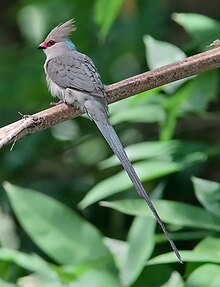
The country's flora and fauna live in a harsh landscape with forest accounting for less than one percent of the total area of the country.[62] Wildlife is spread over three main regions, namely from the northern mountain region of the country to the volcanic plateaux in its southern and central part and culminating in the coastal region.
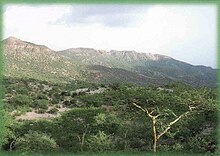
Most species of wildlife are found in the northern part of the country, in the ecosystem of the
According to the country profile related to biodiversity of wildlife in Djibouti, the nation contains more than 820 species of plants, 493 species of invertebrates, 455 species of fish, 40 species of reptiles, 3 species of amphibians, 360 species of birds and 66 species of mammals.[62] Wildlife of Djibouti is also listed as part of Horn of Africa biodiversity hotspot and the Red Sea and Gulf of Aden coral reef hotspot.[63] Mammals include several species of antelope, such as Soemmerring's gazelle and Pelzeln's gazelle. As a result of the hunting ban imposed since early 1970 these species are well conserved now. Other characteristic mammals are
Economy
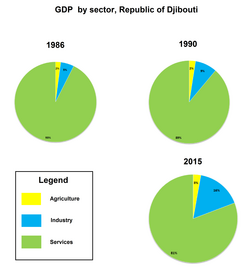
Djibouti's economy is largely concentrated in the service sector. Commercial activities revolve around the country's free trade policies and strategic location as a Red Sea transit point. Due to limited rainfall, vegetables and fruits are the principal production crops, and other food items require importation. The GDP (purchasing power parity) in 2013 was estimated at $2.505 billion, with a real growth rate of 5% annually. Per capita income is around $2,874 (PPP). The services sector constituted around 79.7% of the GDP, followed by industry at 17.3%, and agriculture at 3%.[1]
As of 2013[update], the container terminal at the Port of Djibouti handles the bulk of the nation's trade. About 70% of the seaport's activity consists of imports to and exports from neighboring Ethiopia, which depends on the harbour as its main maritime outlet. The port also serves as an international refueling center and transshipment hub.[1] In 2012, the Djiboutian government in collaboration with DP World started construction of the Doraleh Container Terminal,[66] a third major seaport intended to further develop the national transit capacity.[1] A$396 million project, it has the capacity to accommodate 1.5 million twenty foot container units annually.[66]
Djibouti was ranked the 177th safest investment destination in the world in the March 2011 Euromoney Country Risk rankings.[67] To improve the environment for direct foreign investment, the Djibouti authorities in conjunction with various non-profit organizations have launched a number of development projects aimed at highlighting the country's commercial potential. The government has also introduced new private sector policies targeting high interest and inflation rates, including relaxing the tax burden on enterprises and allowing exemptions on consumption tax.[66]
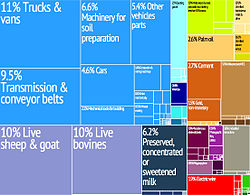
Additionally, efforts have been made to lower the estimated 60% urban unemployment rate by creating more job opportunities through investment in diversified sectors. Funds have especially gone toward building telecommunications infrastructure and increasing disposable income by supporting small businesses. Owing to its growth potential, the fishing and agro-processing sector, which represents around 15% of GDP, has also enjoyed rising investment since 2008.[66]
To expand the modest industrial sector, a 56 megawatt geothermal power plant slated to be completed by 2018 is being constructed with the help of
The Djibouti firm Salt Investment (SIS) began a large-scale operation to industrialize the plentiful salt in Djibouti's Lake Assal region. Operating at an annual capacity of 4 million tons, the desalination project has lifted export revenues, created more job opportunities, and provided more fresh water for the area's residents.[1][66] In 2012, the Djibouti government also enlisted the services of the China Harbor Engineering Company Ltd for the construction of an ore terminal. Worth $64 million, the project is scheduled to be completed within two years[when?] and will enable Djibouti to export a further 5,000 tons of salt per year to markets in Southeast Asia.[68]

Djibouti's gross domestic product expanded by an average of more than 6 percent per year, from US$341 million in 1985 to US$1.5 billion in 2015. The
As of 2010[update], 10 conventional and Islamic banks operate in Djibouti. Most arrived within the past few years, including the Somali money transfer company Dahabshiil and BDCD, a subsidiary of Swiss Financial Investments. The banking system had previously been monopolized by two institutions: the Indo-Suez Bank and the Commercial and Industrial Bank (BCIMR).[69] To assure a robust credit and deposit sector, the government requires commercial banks to maintain 30% of shares in the financial institution;[clarification needed] a minimum of 300 million Djiboutian francs in up-front capital is mandatory for international banks. Lending has likewise been encouraged by the creation of a guarantee fund, which allows banks to issue loans to eligible small- and medium-sized businesses without first requiring a large deposit or other collateral.[66]
Saudi investors are also reportedly exploring the possibility of linking the
Transport in Djibouti

The country's only international airport in Djibouti City serves many intercontinental routes with scheduled and chartered flights. Air Djibouti is the flag carrier of Djibouti and is the country's largest airline.
The
Djibouti's improved natural harbor consists of a roadstead, outer harbor, and inner harbor. The roadstead is well protected by reefs and the configuration of the land. A quarter of Ethiopia's imports and half of its exports move through the ports. Car ferries pass the Gulf of Tadjoura from Djibouti City to Tadjoura.
The Djiboutian highway system is named according to the road classification. Roads that are considered primary roads are those that are fully asphalted (throughout their entire length) and in general they carry traffic between all the major towns in Djibouti.
Media and telecommunications

Telecommunications in Djibouti fall under the authority of the Ministry of Communication.[73]
Radio Television of Djibouti is the state-owned national broadcaster. It operates the sole terrestrial TV station, as well as the two domestic radio networks on AM 1, FM 2, and shortwave 0. Licensing and operation of broadcast media is regulated by the government.[1] Movie theaters include the Odeon Cinema in the capital.[74]
As of 2012[update], there were 215 local internet service providers. Internet users comprised around 99,000 individuals (2015). The internet country top-level domain is .dj.[1]
Tourism in Djibouti
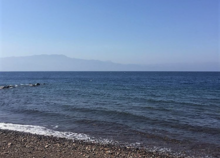
Tourism in Djibouti is one of the growing economic sectors of the country and is an industry that generates 53,000 and 63,000 arrivals per year, with its favorable beaches and climate and also include islands and beaches in the
Energy in Djibouti
According to an August 2003 Energy Information Administration (EIA) analysis brief, Djibouti has an installed electrical power generating capacity of 85 MW, which is generated from an oil-fired generating station in the capital. In 2002 electrical power output was put at 232 GWh, with consumption at 216 GWh. At 2015, per capita annual electricity consumption is about 330 kilowatt-hours (kWh), moreover, about 55% of the population does not have access to electricity, and the level of unmet demand in the country's power sector is significant. Increased hydropower imports from Ethiopia, which currently satisfy 30% of Djibouti demand, will play a significant role in boosting the country's renewable energy supply. The geothermal potential is generated particular interest by Japan, with 13 potential sites, they have already started the construction on one site near Lake Assal. The construction of the Photovoltaic power station (solar farms) in Grand Bara will generated 50 MW capacity.
Demographics
Djibouti has a population of about 1,105,557 inhabitants.
Languages
| Year | Pop. | ±% p.a. |
|---|---|---|
| 1960 | 83,636 | — |
| 1969 | 149,887 | +6.70% |
| 1977 | 277,750 | +8.02% |
| 1980 | 359,247 | +8.95% |
| 1994 | 652,793 | +4.36% |
| 2000 | 722,887 | +1.71% |
| 2012 | 859,652 | +1.45% |
| Source: World Bank[78] | ||
Djibouti is a
Languages of Djibouti
Arabic is of social, cultural and religious importance. In formal settings, it consists of
Religion
Djibouti's population is predominantly
Islam entered the region very early on, as a group of persecuted Muslims had sought refuge across the
The
Largest cities
Template:Largest cities of Djibouti
Health

The life expectancy at birth is around 63.2 for both males and females. Fertility is at 2.35 children per woman.[1] In Djibouti there are about 18 doctors per 100,000 persons.[83]
The 2010 maternal mortality rate per 100,000 births for Djibouti is 300. This is compared with 461.6 in 2008 and 606.5 in 1990. The under 5 mortality rate, per 1,000 births is 95 and the neonatal mortality as a percentage of under 5's mortality are 37. In Djibouti the number of midwives per 1,000 live births is 6 and the lifetime risk of death for pregnant women 1 in 93.[84]
About 93.1% of Djibouti's women and girls have undergone female genital mutilation (female circumcision),[85] a pre-marital custom mainly endemic to Northeast Africa and parts of the Near East that has its ultimate origins in Ancient Egypt.[86][87] Although legally proscribed in 1994, the procedure is still widely practiced, as it is deeply ingrained in the local culture.[88] Encouraged and performed by women in the community, circumcision is primarily intended to deter promiscuity and to offer protection from assault.[88][89]
About 94% of Djibouti's male population have also reportedly undergone male circumcision.[90]
Education
Education is a priority for the government of Djibouti. As of 2009[update], it allocates 20.5% of its annual budget to scholastic instruction.[91]

The Djiboutian educational system was initially formulated to cater to a limited pupil base. As such, the schooling framework was largely elitist and drew considerably from the French colonial paradigm, which was ill-suited to local circumstances and needs.[91]
In the late 1990s, the Djiboutian authorities revised the national educational strategy and launched a broad-based consultative process involving administrative officials, teachers, parents, national assembly members and NGOs. The initiative identified areas in need of attention and produced concrete recommendations on how to go about improving them. The government subsequently prepared a comprehensive reform plan aimed at modernizing the educational sector over the 2000–10 period. In August 2000, it passed an official Education Planning Act and drafted a medium-term development plan for the next five years. The fundamental academic system was significantly restructured and made compulsory; it now consists of five years of primary school and four years of middle school. Secondary schools also require a Certificate of Fundamental Education for admission. In addition, the new law introduced secondary-level vocational instruction and established university facilities in the country.[91]
As a result of the Education Planning Act and the medium-term action strategy, substantial progress has been registered throughout the educational sector.[91] In particular, school enrollment, attendance, and retention rates have all steadily increased, with some regional variation. From 2004 to 2005 to 2007–08, net enrollments of girls in primary school rose by 18.6%; for boys, it increased 8.0%. Net enrollments in middle school over the same period rose by 72.4% for girls and 52.2% for boys. At the secondary level, the rate of increase in net enrollments was 49.8% for girls and 56.1% for boys.[92]
The Djiboutian government has especially focused on developing and improving institutional infrastructure and teaching materials, including constructing new classrooms and supplying textbooks. At the post-secondary level, emphasis has also been placed on producing qualified instructors and encouraging out-of-school youngsters to pursue vocational training.[91] As of 2012[update], the literacy rate in Djibouti was estimated at 70%.[93]
Institutions of higher learning in the country include the University of Djibouti.
Culture

Djiboutian attire reflects the region's hot and arid climate. When not dressed in Western clothing such as jeans and T-shirts, men typically wear the macawiis, which is a traditional sarong-like garment worn around the waist. Many nomadic people wear a loosely wrapped white cotton robe called a tobe that goes down to about the knee, with the end thrown over the shoulder (much like a Roman toga).
Women typically wear the dirac, which is a long, light, diaphanous
A lot of Djibouti's original art is passed on and preserved orally, mainly through song. Many examples of Islamic, Ottoman, and French influences can also be noted in the local buildings, which contain plasterwork, carefully constructed motifs, and calligraphy.
Music
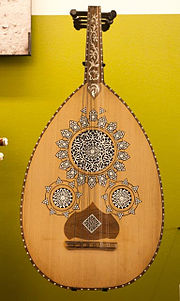
Somalis have a rich musical heritage centered on traditional Somali folklore. Most Somali songs are pentatonic. That is, they only use five pitches per octave in contrast to a heptatonic (seven note) scale such as the major scale. At first listen, Somali music might be mistaken for the sounds of nearby regions such as Ethiopia, Sudan or the Arabian Peninsula, but it is ultimately recognizable by its own unique tunes and styles. Somali songs are usually the product of collaboration between lyricists (midho), songwriters (laxan) and singers (codka or "voice"). Balwo is a Somali musical style centered on love themes that is popular in Djibouti.[95]
Traditional Afar music resembles the folk music of other parts of the Horn of Africa such as Ethiopia; it also contains elements of Arabic music. The history of Djibouti is recorded in the poetry and songs of its nomadic people, and goes back thousands of years to a time when the peoples of Djibouti traded hides and skins for the perfumes and spices of ancient Egypt, India and China. Afar oral literature is also quite musical. It comes in many varieties, including songs for weddings, war, praise and boasting.[96]
Literature
Djibouti has a long tradition of poetry. Several well-developed Somali forms of verse include the gabay, jiifto, geeraar, wiglo, buraanbur, beercade, afarey and guuraw. The gabay (epic poem) has the most complex length and meter, often exceeding 100 lines. It is considered the mark of poetic attainment when a young poet is able to compose such verse, and is regarded as the height of poetry. Groups of memorizers and reciters (hafidayaal) traditionally propagated the well-developed art form. Poems revolve around several main themes, including baroorodiiq (elegy), amaan (praise), jacayl (romance), guhaadin (diatribe), digasho (gloating) and guubaabo (guidance). The baroorodiiq is composed to commemorate the death of a prominent poet or figure.[97] The Afar are familiar with the ginnili, a kind of warrior-poet and diviner, and have a rich oral tradition of folk stories. They also have an extensive repertoire of battle songs.[98]
Additionally, Djibouti has a long tradition of Islamic literature. Among the most prominent such historical works is the medieval Futuh Al-Habash by Shihāb al-Dīn, which chronicles the
Sport
Football is the most popular sport amongst Djiboutians. The country became a member of
Cuisine

See also
Notes
- ^ a b c d e f g h i j k l m n o p q r s t u v w x y "Djibouti". The World Factbook. CIA. 5 February 2013. Retrieved 26 February 2013.
- ^ a b "World Population Prospects 2022". United Nations Department of Economic and Social Affairs, Population Division. Retrieved 17 July 2022.
- ^ a b "World Population Prospects 2022: Demographic indicators by region, subregion and country, annually for 1950-2100" (XSLX) ("Total Population, as of 1 July (thousands)"). United Nations Department of Economic and Social Affairs, Population Division. Retrieved 17 July 2022.
- ^ a b c d "Djibouti". International Monetary Fund.
- ^ "2016 Human Development Report" (PDF). United Nations Development Programme. 2016. Retrieved 21 March 2017.
- ^ a b Raph Uwechue, Africa year book and who's who, (Africa Journal Ltd.: 1977), p.209.
- ^ a b Chisholm, Hugh, ed. (1911). . Encyclopædia Britannica. Vol. 25 (11th ed.). Cambridge University Press. p. 383.
- ^ a b c A Political Chronology of Africa, (Taylor & Francis), p.132.
- ^ Chisholm, Hugh, ed. (1911). . Encyclopædia Britannica. Vol. 28 (11th ed.). Cambridge University Press. p. 950.
- ^ "Today in Djibouti History". Historyorb.com. Retrieved 27 April 2011.
- ^ "United Nations member states". United Nations. Retrieved 27 April 2011.
- ^ Zarins, Juris (1990), "Early Pastoral Nomadism and the Settlement of Lower Mesopotamia", (Bulletin of the American Schools of Oriental Research)
- ISBN 0759104662. Retrieved 8 September 2014.
- ISBN 3447051752. Retrieved 7 September 2014.
- ISBN 1134403038. Retrieved 7 September 2014.
- ^ Universität Frankfurt am Main (2003). Journal of African Archaeology, Volumes 1–2. Africa Manga Verlag. p. 230. Retrieved 7 September 2014.
- )
- ^ Fattovich, Rodolfo (1987). "Some remarks on the origins of the Aksumite Stelae" (PDF). Annales d'Éthiopie. 14 (14): 43–69. Retrieved 7 September 2014.[permanent dead link]
- ^ Simson Najovits, Egypt, Trunk of the Tree, Volume 2, (Algora Publishing: 2004), p.258.
- ^ Tyldesley, Hatchepsut, p.147
- ^ Breasted 1906–07, pp. 246–295, vol. 1.
- ^ "A Country Study: Somalia from The Library of Congress". Lcweb2.loc.gov. Retrieved 27 April 2011.
- ISBN 1598842048.
- ISBN 0415348102.
- ISBN 1841623717.
- ^ a b Encyclopedia Americana, Volume 25. Americana Corporation. 1965. p. 255.
- ^ a b Lewis, I.M. (1955). Peoples of the Horn of Africa: Somali, Afar and Saho. International African Institute. p. 140.
- ^ "Archived copy". Archived from the original on 9 June 2013. Retrieved 19 April 2013.
{{cite web}}: Unknown parameter|deadurl=ignored (|url-status=suggested) (help)CS1 maint: archived copy as title (link) FRENCH SOMALI COAST Timeline - ^ Ben Cahoon. "Djibouti". Worldstatesmen.org. Retrieved 27 April 2011.
- ^ ISBN 0472068989
- ^ Africa Research, Ltd (1966). Africa Research Bulletin, Volume 3. Blackwell. p. 597. Retrieved 18 December 2014.
- ^ American Universities Field Staff, Northeast Africa series, Volume 15, Issue 1, (American Universities Field Staff.: 1968), p. 3.
- ^ Legion-Etrangere. Legion-Etrangere. 2000. p. 2.
- ^ Alvin J. Cottrell, Robert Michael Burrell, Georgetown University. Center for Strategic and International Studies, The Indian Ocean: its political, economic, and military importance, (Praeger: 1972), p. 166.
- ^ Newsweek, Volume 81, (Newsweek: 1973), p. 254.
- ^ Elections in Djibouti African Elections Database
- ^ a b c d "Djibouti's Constitution of 1992 with Amendments through 2010" (PDF). Constitute. Retrieved 19 July 2016.
- ^ a b c d "Constitution de la République de Djibouti" (in French). Agence Djiboutienne d'Information. Retrieved 30 March 2013.
- ^ a b "Djibouti". Freedom House. Retrieved 30 March 2013.
- ^ a b "DJIBOUTI: Guelleh sworn in for second presidential term". IRIN Africa. 9 May 2005. Retrieved 20 March 2013.
- ^ "Elections in Djibouti". African Elections Database. Retrieved 30 March 2013.
- ^ a b "Djibouti validates presidential election". Middle East Online. 13 April 2011. Retrieved 30 March 2013.
- ^ "Sudan: President Al-Bashir Congratulates Djibouti President On His Re-Election". Sudan News Agency. 20 April 2011. Retrieved 30 March 2013.
- ^ "Joint statement of the international observer missions of the Djibouti presidential elections held on April 08, 2011". Intergovernmental Authority on Development. 10 April 2011. Retrieved 30 March 2013.
In view of the foregoing, the international mission found that the election of 8 April 2011 was peaceful, calm, fair, transparent and took place in dignity. It declares that the election was free and democratic.
- ^ "M. Abdoulkader Kamil Mohamed, grand commis de l'Etat et nouveau Premier ministre djiboutien". Adjib. Retrieved 1 April 2013.
- ^ "Djibouti government reaches deal to bring opposition into parliament". Goobjoog. 30 December 2014. Retrieved 1 January 2015.
- ^ Freedom House (2011). "Freedom in the World 2011: Djibouti". Freedom House. Retrieved 6 August 2012.
- ^ Peligal, Rona (17 February 2011). "Djibouti: Call to Drop Charges and Release Jean-Paul Noël Abdi, President of the Djiboutian League of Human Rights (Letter to His Excellency Ismail Omar Guelleh, President of the Republic of Djibouti)". Human Rights Watch. Retrieved 6 August 2012.
- ^ "Djibouti: Further information: Activist released but charges remain: Jean-Paul Noel Abdi". Amnesty International. 23 February 2011. Retrieved 6 August 2012.
- ^ The Rise and Fall of the Somalia Airforce: A Diary Reflection
- ^ "Somalia: UN Envoy Says Inauguration of New Parliament in Somalia 'Historic Moment'". Forum on China-Africa Cooperation. 21 August 2012. Retrieved 24 August 2012.
- ^ Mahmoud Mohamed (17 September 2012). "Presidential inauguration ushers in new era for Somalia". Sabahi. Retrieved 30 September 2012.
- ^ "Djibouti Is Hot". Bloomberg.com. Retrieved 19 September 2017.
- ^ "Djibouti: The superpowers' playground". The Economist. 9 April 2016. Retrieved 12 April 2016.
- ISBN 113663696X. Retrieved 24 September 2016.
- ^ Geothermal Resources Council (1985). 1985 International Symposium on Geothermal Energy, Volume 9, Part 1. p. 175.
- ^ a b Highest Mountains in Djibouti. geonames.org
- ^ "Eritrean coastal desert". Terrestrial Ecoregions. World Wildlife Fund.
- ^ a b "Weatherbase : Djibouti". Retrieved 1 July 2015.
{{cite web}}: Unknown parameter|deadurl=ignored (|url-status=suggested) (help) - ^ "Djibouti to source 100% of its energy from renewables by 2020". climateactionprogramme.org. Retrieved 29 May 2015.
- ^ a b "Le Pèlerin du Day". World Food Programme. Retrieved 27 February 2013.
- ^ "Djibouti". Living National Treasures. Retrieved 27 February 2013.
- ISBN 978-2-88032-977-8. Retrieved 28 May 2011.
- ISBN 978-2-8317-0021-2. Retrieved 28 May 2011.
- ^ a b c d e f g h Ridhima Bansal. "Current Development Projects and Future Opportunities in Djibouti". Association of African Entrepreneurs. Retrieved 26 February 2013.
- ^ "Euromoney Country Risk". Euromoney Country Risk. Euromoney Institutional Investor PLC. Retrieved 15 August 2011.
- ^ "Djibouti, China Sign 64 mln USD Agreement to Facilitate Salt Export". Xinhua News Agency. 20 November 2012. Retrieved 27 February 2013.
- ^ a b "Djibouti banking boom attracts foreign investors". Reuters. 23 March 2010. Retrieved 27 February 2013.
- ^ Le système informel de transferts de fonds et le mécanisme automatique du Currency Board : complémentarité ou antagonisme ? Le cas des transferts des hawalas à Djibouti Archived 24 February 2014 at the Wayback Machine. univ-orleans.fr
- ^ kuschk (27 June 2011). "Bridge of the Horns, Cities of Light: Will They Ever Actually Be Built?". The Basement Geographer. WordPress. Retrieved 1 September 2015.
- ^ "Phase I of Yemen and Djibouti Causeway delayed". Steelguru.com. 22 June 2010. Retrieved 24 March 2016.
- ^ "Chiefs of State and Cabinet Members of Foreign Governments". CIA. Retrieved 23 November 2016.
- ^ "Movie theaters in Djibouti, Djibouti". Cinema Treasures. Retrieved 24 November 2016.
- ^ "Djibouti: Tourism, travel, and recreation". Nations Encyclopedia. Retrieved 5 June 2008.
- ^ "Mecometer Tourism". Mecometer.
- ^ Kevin Anglin, Becca Blond and Jean-Bernard Carillet, Africa on a Shoestring (London: Lonely Planet, 2004), p. 698.
- ^ "World Bank". Retrieved 26 October 2015.
- ^ a b "Djibouti – Languages". Ethnologue. Retrieved 6 September 2016.
- ^ Chapter 1: Religious Affiliation. Retrieved 4 September 2013
- ^ United Nations High Commissioner for Refugees. "Immigration and Refugee Board of Canada, "Djibouti: Situation and treatment of Christians, including instances of discrimination or violence; effectiveness of recourse available in cases of mistreatment; problems that a Muslim can face if he or she converts to Christianity or marries a Christian (2000–2009)", 5 August 2009". Unhcr.org. Retrieved 20 June 2010.
- ^ David M. Cheney. "Diocese of Djibouti". Catholic-hierarchy.org. Retrieved 28 February 2013.
- ^ "Republic of Djibouti: Humanitarian Country Profile". IRIN. February 2007. Archived from the original on 17 February 2010. Retrieved 20 June 2010.
- ^ "The State of the World's Midwifery". United Nations Population Fund. Retrieved 1 August 2011.
- ^ "Prevalence of FGM". Who.int. 9 December 2010. Retrieved 27 April 2011.
- .
- ISBN 1555875785.
- ^ a b "DJIBOUTI: Women fight mutilation". IRIN. 12 July 2005. Retrieved 27 April 2011.
- ISBN 1563081318.
- ^ Eric Werker; Amrita Ahuja; Brian Wendell. "Male Circumcision and AIDS: The Macroeconomic Impact of a Health Crisis" (PDF). NEUDC 2007 Papers :: Northeast Universities Development Consortium Conference: Center for International Development at Harvard Un. Retrieved 27 April 2011.
- ^ a b c d e Hare, Harry (2007) ICT in Education in Djibouti, World Bank
- ^ Djibouti Assistance to Education Evaluation. USAID (April 2009)
- ISBN 0756698596.
- ^ "Image of Djibouti women in head-dresses". discoverfrance.net.
- ^ Mohamed Diriye Abdullahi, Culture and Customs of Somalia, (Greenwood Press: 2001), pp.170–172.
- ^ "Djibouti – Culture Overview". Expedition Earth. Archived from the original on 27 February 2004. Retrieved 28 September 2005. – Website no longer exists; link is to Internet Archive
- ^ Mohamed Diriye Abdullahi (2001) Culture and Customs of Somalia, Greenwood Press, pp. 75–76
- ^ Matt Phillips, Jean-Bernard Carillet (2006) Lonely Planet Ethiopia and Eritrea, Lonely Planet. p.301.
- ^ Shihāb al-Dīn Aḥmad ibn ʻAbd al-Qādir ʻArabfaqīh, Translated by Paul Stenhouse, Richard Pankhurst (2003). The conquest of Abyssinia: 16th century. Tsehai Publishers & Distributors. p. 77.
{{cite book}}: CS1 maint: multiple names: authors list (link) - ^ Barlin Ali, Somali Cuisine, (AuthorHouse: 2007), p.79
References
 This article incorporates public domain material from The World Factbook. CIA.
This article incorporates public domain material from The World Factbook. CIA.
External links
- Government
- "Site Officiel de la République de Djibouti" [Official website of the Republic of Djibouti] (in French). Government of Djibouti.
- "Office National de Tourisme de Djibouti". National Official of Tourism of Djibouti.
- Profile
- "Djibouti". The World Factbook (2024 ed.). Central Intelligence Agency.
- Djibouti profile from the BBC News.
- Djibouti web resources provided by GovPubs at the University of Colorado Boulder Libraries
- Djibouti at Curlie
- Other








